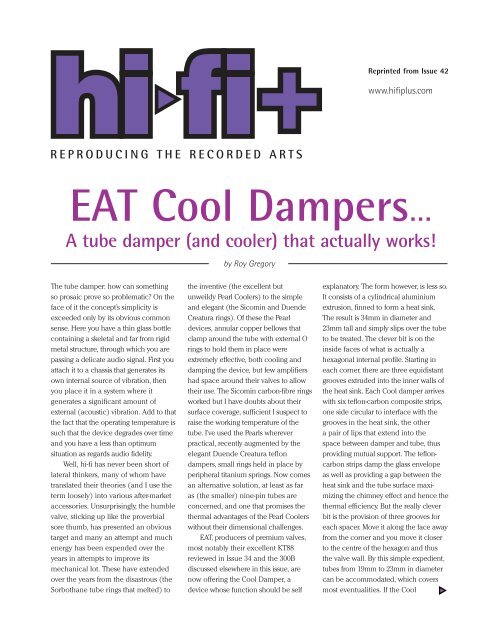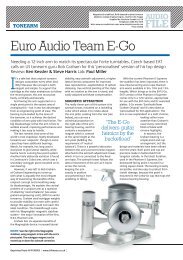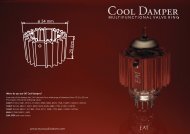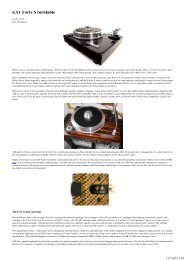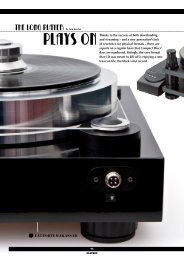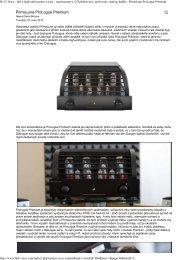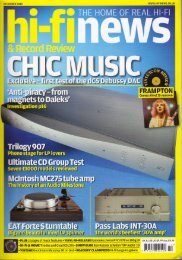Hi-Fi + - EAT Cool Dampers - EuroAudioTeam.com
Hi-Fi + - EAT Cool Dampers - EuroAudioTeam.com
Hi-Fi + - EAT Cool Dampers - EuroAudioTeam.com
You also want an ePaper? Increase the reach of your titles
YUMPU automatically turns print PDFs into web optimized ePapers that Google loves.
REPRODUCING THE RECORDED ARTS<br />
<strong>EAT</strong> <strong>Cool</strong> <strong>Dampers</strong>…<br />
A tube damper (and cooler) that actually works!<br />
The tube damper: how can something<br />
so prosaic prove so problematic? On the<br />
face of it the concept’s simplicity is<br />
exceeded only by its obvious <strong>com</strong>mon<br />
sense. Here you have a thin glass bottle<br />
containing a skeletal and far from rigid<br />
metal structure, through which you are<br />
passing a delicate audio signal. <strong>Fi</strong>rst you<br />
attach it to a chassis that generates its<br />
own internal source of vibration, then<br />
you place it in a system where it<br />
generates a significant amount of<br />
external (acoustic) vibration. Add to that<br />
the fact that the operating temperature is<br />
such that the device degrades over time<br />
and you have a less than optimum<br />
situation as regards audio fidelity.<br />
Well, hi-fi has never been short of<br />
lateral thinkers, many of whom have<br />
translated their theories (and I use the<br />
term loosely) into various after-market<br />
accessories. Unsurprisingly, the humble<br />
valve, sticking up like the proverbial<br />
sore thumb, has presented an obvious<br />
target and many an attempt and much<br />
energy has been expended over the<br />
years in attempts to improve its<br />
mechanical lot. These have extended<br />
over the years from the disastrous (the<br />
Sorbothane tube rings that melted) to<br />
by Roy Gregory<br />
the inventive (the excellent but<br />
unweildy Pearl <strong>Cool</strong>ers) to the simple<br />
and elegant (the Si<strong>com</strong>in and Duende<br />
Creatura rings). Of these the Pearl<br />
devices, annular copper bellows that<br />
clamp around the tube with external O<br />
rings to hold them in place were<br />
extremely effective, both cooling and<br />
damping the device, but few amplifiers<br />
had space around their valves to allow<br />
their use. The Si<strong>com</strong>in carbon-fibre rings<br />
worked but I have doubts about their<br />
surface coverage, sufficient I suspect to<br />
raise the working temperature of the<br />
tube. I’ve used the Pearls wherever<br />
practical, recently augmented by the<br />
elegant Duende Creatura teflon<br />
dampers, small rings held in place by<br />
peripheral titanium springs. Now <strong>com</strong>es<br />
an alternative solution, at least as far<br />
as (the smaller) nine-pin tubes are<br />
concerned, and one that promises the<br />
thermal advantages of the Pearl <strong>Cool</strong>ers<br />
without their dimensional challenges.<br />
<strong>EAT</strong>, producers of premium valves,<br />
most notably their excellent KT88<br />
reviewed in Issue 34 and the 300B<br />
discussed elsewhere in this issue, are<br />
now offering the <strong>Cool</strong> Damper, a<br />
device whose function should be self<br />
Reprinted from Issue 42<br />
www.hifiplus.<strong>com</strong><br />
explanatory. The form however, is less so.<br />
It consists of a cylindrical aluminium<br />
extrusion, finned to form a heat sink.<br />
The result is 34mm in diameter and<br />
23mm tall and simply slips over the tube<br />
to be treated. The clever bit is on the<br />
inside faces of what is actually a<br />
hexagonal internal profile. Starting in<br />
each corner, there are three equidistant<br />
grooves extruded into the inner walls of<br />
the heat sink. Each <strong>Cool</strong> damper arrives<br />
with six teflon-carbon <strong>com</strong>posite strips,<br />
one side circular to interface with the<br />
grooves in the heat sink, the other<br />
a pair of lips that extend into the<br />
space between damper and tube, thus<br />
providing mutual support. The tefloncarbon<br />
strips damp the glass envelope<br />
as well as providing a gap between the<br />
heat sink and the tube surface maximizing<br />
the chimney effect and hence the<br />
thermal efficiency. But the really clever<br />
bit is the provision of three grooves for<br />
each spacer. Move it along the face away<br />
from the corner and you move it closer<br />
to the centre of the hexagon and thus<br />
the valve wall. By this simple expedient,<br />
tubes from 19mm to 23mm in diameter<br />
can be ac<strong>com</strong>modated, which covers<br />
most eventualities. If the <strong>Cool</strong>
Damper slips down the tube in use it<br />
needs the strips adjusting. That aside,<br />
installation is a cinch. All you need<br />
to do is decide whether you want<br />
ostentatious red or the more subtle grey<br />
versions. The <strong>Cool</strong> <strong>Dampers</strong> cost £15<br />
each and if required, a rather nice<br />
storage box that will hold up to 12<br />
<strong>Dampers</strong> beneath its magnetically<br />
retained lid will set you back another<br />
£25. Why you’d want this item is slightly<br />
beyond me, as once you’ve heard the<br />
<strong>Cool</strong> <strong>Dampers</strong> in your system, the last<br />
place you’ll want them is sitting in a box.<br />
I used the <strong>Cool</strong> <strong>Dampers</strong> with the cj<br />
CT5 and also in place of the Pearl<br />
devices which are a permanent fit on the<br />
input tubes and phase splitters of the<br />
JA30s, thus employing them both in<br />
pre and power environments. I<br />
had insufficient to try them with<br />
the EL84s in the Linear Bs<br />
but that is an attractive<br />
alternative application which<br />
I’ll investigate if and when I can<br />
prise 16 <strong>Cool</strong> <strong>Dampers</strong> out of<br />
<strong>EAT</strong>/Absolute Sounds.<br />
In use, the <strong>EAT</strong> dampers run<br />
hot, which speaks volumes<br />
for their thermal<br />
efficiency. At the<br />
end of the day<br />
I can’t <strong>com</strong>ment on<br />
their impact on the<br />
longevity of tubes, but<br />
Pearl have convincing<br />
data on the subject of their devices. In<br />
the end, the efficiency of any heat sink<br />
depends on its area and the Pearls, with<br />
their much deeper fins score in that<br />
regard. Whether that difference is critical<br />
is hard to say, especially when you<br />
consider that in many instances the<br />
demands they make on space precludes<br />
their use. In the case of the CT5 they<br />
would only fit if the perspex finning that<br />
guards the tubes were removed, an<br />
unlikely and visually reductive step. So<br />
the <strong>EAT</strong>s score big on practicality with<br />
no issues regarding installation. Indeed,<br />
my only concern would be using them<br />
on horizontally mounted tubes where<br />
the lack of chimney effect might actually<br />
result in the device running hotter!<br />
Sonically, the <strong>EAT</strong> <strong>Cool</strong> <strong>Dampers</strong> are<br />
a conspicuous success. Compared to the<br />
Duendes in the CT5, they delivered a<br />
fuller, more powerful sound, with greater<br />
weight AND definition: no trade off here<br />
between energy and definition. Playing<br />
Steve Dawson’s superb soul homage<br />
‘Love Is A Blessing’ (from the Dolly<br />
Varden front-man’s new solo album<br />
Sweet Is The Anchor – Undertow CD-<br />
UMC-026) the bass is deeper, more<br />
tactile and far more<br />
pitch precise,<br />
underpinning the<br />
funk groove that<br />
drives the track.<br />
Texture and<br />
attack on<br />
acoustic guitars<br />
is far more individual,<br />
with better definition of harmonic<br />
structures. Voices are more natural, both<br />
tonally and in terms of diction, which<br />
with the better localization and<br />
separation allows them to project better,<br />
with greater impact and meaning. The<br />
separation of the close harmonies on the<br />
title track is breath-taking in its fragile<br />
beauty. In short, the sonic impact is<br />
wholly positive, while the promise of<br />
greater consistency through a longer<br />
working life is an added bonus. The<br />
results were consistent too across the<br />
various amps and applications. In every<br />
case, separation and detail were<br />
improved without robbing the system<br />
of energy or impairing musical flow.<br />
In fact, the cleaner, more precise bass<br />
gave a wel<strong>com</strong>e boost to the pacing and<br />
momentum of tracks, further reducing<br />
the mechanics of reproduction.<br />
The <strong>EAT</strong> <strong>Cool</strong> <strong>Dampers</strong> are one of<br />
those accessories that at £15 each are<br />
cheap enough to simply buy on a whim.<br />
Perhaps that’s a good thing – perhaps<br />
not. Don’t make the mistake of simply<br />
installing them and leaving them alone.<br />
They deserve the time and attention<br />
required to listen and assess their<br />
impact properly. They’re<br />
surprisingly beneficial to the<br />
point that I can’t see<br />
their cost ruling them<br />
out, even in the case<br />
of the most budget<br />
conscious valve<br />
electronics – perhaps<br />
the arena in which<br />
they’ll have the greatest<br />
influence. Tube outputs in<br />
Chinese CD players anyone?<br />
As with all devices that influence the<br />
mechanical/environmental aspects of<br />
system performance, results will vary<br />
with different situations, but if they<br />
even begin to approach what I’ve heard<br />
here they’ll deliver ample reward for<br />
the funds and time invested. What’s<br />
more, they might just go some way<br />
to restoring your faith that genuine,<br />
musical benefits don’t have to cost<br />
the earth. An early audition is<br />
enthusiastically re<strong>com</strong>mended.<br />
<strong>EAT</strong> <strong>Cool</strong> <strong>Dampers</strong><br />
£15 ea.<br />
UK Distributor:<br />
Absolute Sounds<br />
Tel. (44)(0)20 8971 3909<br />
Net. www.absolutesounds.<strong>com</strong>
I love transistors; they do so many things right. It’s just that I<br />
finally realized that tubes do even more things right – at least<br />
sonically speaking. Right about now, a few of my long time<br />
friends are probably rolling on the floor and laughing their<br />
head’s off. Clearly, I wasn’t always a tube person. Sometime in<br />
the early 1990's I had this operation you see....<br />
The last 35+ years have been quite an interesting path for<br />
me as a hobbyist. The learning curve has been tremendous<br />
and along the way one of the most important things I’ve<br />
learned is that tastes definitely change. Today I’m living with<br />
a system I truly love but one that a few years back I’d have<br />
bet big money I would never, ever own. I’ve gone from a very<br />
large listening room to a much smaller<br />
one, an equally massive set-up to<br />
a (physically at least) much<br />
more modest one. I’ve gone<br />
from transistors to tubes –<br />
and within the tube family,<br />
I’ve been able to enjoy the<br />
fruits of KT99s, KT90s,<br />
KT88s, Tung-Sol 6550s,<br />
Svetlana/Sovtek 6550s and<br />
now 300Bs. It’s my recent<br />
experiences with the latter that<br />
I’m going to share, starting with the<br />
epiphany represented by Euro Audio<br />
Team’s version of this venerable design.<br />
My current amplifiers are strange little<br />
beasts. They are Manley Neo-Classic SE-PP 300s<br />
and they allow you to switch from push-pull to<br />
triode mode. Yes, you read that correctly. You can<br />
even do this ‘on the fly’. In other words, mute the amps, flip the<br />
toggle and you can hear the transformer<br />
whining (in every sense of the word) as it switches from either<br />
triode to push-pull or vice-versa. If, like me, you’re at a loss to<br />
understand how this is achieved then I refer you to the Manley<br />
website which offers considerable insight into the design<br />
philosophy of the amplifier. As I’m principally concerned with<br />
tubes here, that’s the place to find the answer to the “what is<br />
he talking about?” dilemma I’ve just posed.<br />
The <strong>Hi</strong>story Man<br />
by Richard S. Foster<br />
The Euro Audio Team 300B<br />
(http://www.manleylabs.<strong>com</strong>/containerpages/seppneo.html)<br />
Let me state right now how much I love these amps. I<br />
spent considerable time listening to a variety of amplifiers to<br />
match my JMlab Micros. As we’ve said many times, the amp<br />
/speaker interface is one of the most critical in the system and<br />
never more so than with a ruthless little mother like the Micro.<br />
Yet the moment I hooked the Neo-Classics<br />
up, I knew they were a perfect<br />
match and I’ve never regretted that<br />
decision. I have all the power I<br />
need for these speakers (now<br />
the Micro Be’s) and the best<br />
part is the amplifiers do not<br />
heat up my room in the hot<br />
and humid summer. There’s<br />
nothing worse than an<br />
indoor barbecue with lots<br />
of glass as the cooker.<br />
Believe me because I say<br />
that as someone with 16<br />
KT88s running simultaneous<br />
overtime in his past.<br />
The Manleys run a single pair<br />
of 300Bs per side (there’s also a<br />
6SL7 input tube, a 6SN7 driver<br />
tube and a pair of 5U4 rectifiers).<br />
They deliver 25 watts in push-pull<br />
mode and 12 Watts single-ended. They<br />
also arrived equipped with Electro Harmonix tubes<br />
(all save the rectifiers). Now, tube quality varies and<br />
some OEM suppliers are more reliable than others.<br />
The Sovtek 6922 and 6550A are good examples of dependable<br />
product that’s been around for a while and I had no reason to<br />
be suspicious of the Electro Harmonix items that issue from<br />
the same supplier.<br />
Let me first say that I’d been living with the original tubes<br />
in the amplifiers since mid-2002. The crackle/noise issues<br />
began in 2004 and this is when I decided – with the help of<br />
my friends – that it was time to do something about the<br />
glassware. Initially, it was a noise issue with the input and
driver tubes. Advice and experience has led me to a ‘Black<br />
Base’ Philips 5691 as the input tube (6SL7), and a Sylvania<br />
Mil Spec 6SN7WGTA for the driver tube. The crackle I’d<br />
occasionally suffered is now history. But the other (sonic)<br />
benefits made me cast a jaundiced eye in the direction of the<br />
output tubes, so, later that year when I was offered a quartet<br />
of <strong>EAT</strong> 300Bs by Ms. Jozefina Krahulcova, President of Euro<br />
Audio Team, I was quick to accept.<br />
Changing tubes isn’t a plug and play proposition. I took<br />
a day last fall and installed the <strong>EAT</strong> tubes. Biasing on this<br />
amplifier is set between 490 and 510 mVDC. Initially I turned<br />
the biasing almost off when the tubes were installed. I brought<br />
them up to level after allowing them to warm up for about an<br />
hour. I was very surprised over the next few days as to just how<br />
stable the tubes were. Only the smallest of adjustments was<br />
necessary and now I check them perhaps once a week with<br />
almost no adjustment necessary.<br />
Well, with the tubes installed and stable, I was excited to<br />
say the least. I’d read the excellent review by Chris Binns in<br />
Issue 34 of their KT88's and so I had high expectations for the<br />
300B. Let me also say that the visuals on this tube are quite<br />
imposing. It’s about an inch or so taller than other 300B tubes<br />
I’ve <strong>com</strong>e across and looks great!<br />
The moment of truth was at hand and I duly cued up<br />
something familiar – the Speakers Corner re-issue of Mercury<br />
SR90153, The Birds. I still remember the moment the stylus<br />
hit the opening grooves… and my jaw hit the floor. The<br />
amplifiers had been literally transformed into these <strong>Fi</strong>rebreathing<br />
Dragons with seemingly unlimited power and<br />
authority! I couldn’t believe what I was hearing. I sat and<br />
listened transfixed to the entire side. Then it was on to the<br />
Willem Makkee re-mastered copy of The Doors’ LA Woman.<br />
This time it was the whole record I played. And it continued<br />
like this for days. All the records I listened to were transformed.<br />
Joan Baez, on Cisco’s magnificent reissue of Farewell, Angelina<br />
had a purity of tone I’d only dreamed was on the record.<br />
Where it had been closed in (which I only heard after the<br />
change to the <strong>EAT</strong> product) her voice now held this power<br />
and openness that was nothing short of astonishing.<br />
I am now hearing what the amplifier is capable of<br />
delivering: pure, open, effortless sound with absolutely no<br />
apparent restraint. Only after I switched to these tubes did I<br />
realize that the Electro-Harmonix product was so weak and<br />
closed in. Now more than ever, the match that I thought I<br />
was getting for my speakers is truly secure.<br />
These tubes, in my amplifiers, not only give me seemingly<br />
limitless headroom, there is a speed and clarity I never<br />
expected from a 300B. I listen mostly in the push-pull<br />
configuration, however I occasionally play in the single-ended<br />
mode and even then find that these tubes offer outstanding<br />
bass control. Where the Electro-Harmonix was thin sounding,<br />
suffering a bit of glare or harshness on vocal tracks, the <strong>EAT</strong> is<br />
rich, solid and crisply defined, cleanly handling dynamic steps<br />
at both ends of the scale. I’ve found that in either PP or SE, the<br />
<strong>EAT</strong> tubes have a transparency and focus, a see-through quality<br />
with none of the syrupy mush and added softness one tends<br />
to associate with the number 300B. The tube is fast, leading<br />
edge transients being beautifully traced. Yes, that’s right. It’s<br />
got great dynamic swing and fabulous control, wonderful<br />
neutrality and is amazingly even from bottom to the very top.<br />
There’s no pear shaped sound here, no flabby bottom or<br />
rounded and rolled off highs. It’s a very natural and musical<br />
product, one I’d expect to give years of listening pleasure. If it<br />
lasts as long as the solid construction suggests it should, then<br />
the sonic benefits make it an extremely cost-effective upgrade<br />
on stock tubes.<br />
To be fair, this is not my final word on the 300B. Impressive<br />
as the <strong>EAT</strong>s undoubtedly are, the huge gap in performance<br />
between them and the OEM Electro Harmonix tubes makes<br />
me wonder how they stack up against the other audiophile<br />
offerings out there. I now have another three quartets in house<br />
and you can expect the news shortly as to how the <strong>EAT</strong><br />
<strong>com</strong>pares to the Western Electric 300B and Gold Dragon’s<br />
4300BC and 300BM.<br />
The difference is that now it’s a matter of interest rather<br />
than musical necessity. The <strong>EAT</strong> 300B has been a 100%<br />
totally reliable product. Whilst initial impressions with the<br />
alternatives suggest that there are definite differences in<br />
presentation I really couldn’t be happier and I have<br />
absolutely no reservations in re<strong>com</strong>mending this tube<br />
to anyone looking for a great sounding, reliable 300B.<br />
As a benchmark it sets the bar awfully high.<br />
Manufacturer’s Technical Specifications:<br />
Valve Type: 300B Triode<br />
Amplification Factor: 3.9<br />
<strong>Fi</strong>lament Voltage: 5 Volts<br />
<strong>Fi</strong>lament current: 1.25 Amps<br />
Cathode: Oxide, directly heated<br />
Maximum Anode Dissipation: 36 W<br />
Transconductance: 5 mA/V<br />
Maximum DC Anode Voltage: 450 V<br />
Measured Value If: 1.1 A<br />
Price: £582/pair<br />
UK Distributor:<br />
Absolute Sounds<br />
Tel. (44)(0)20 8971 3909<br />
Net. www.absolutesounds.<strong>com</strong><br />
Manufacturer:<br />
Euro Audio Team<br />
Net www.euroaudioteam.<strong>com</strong>


